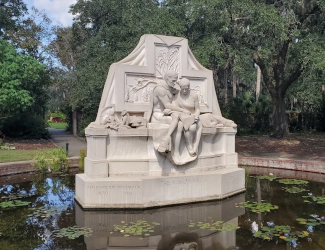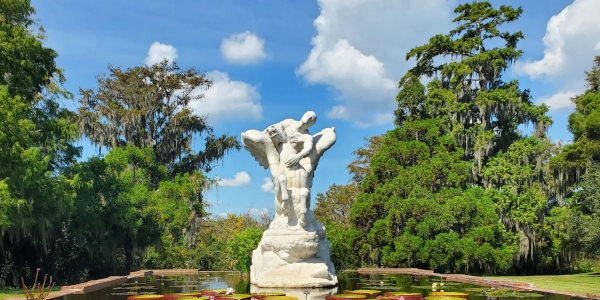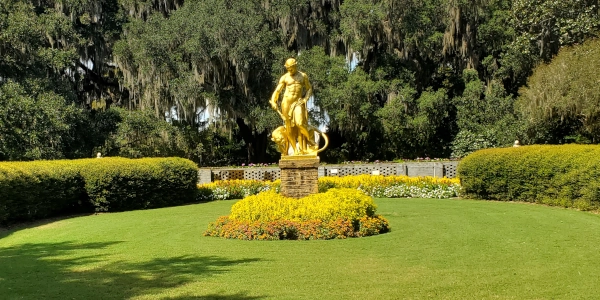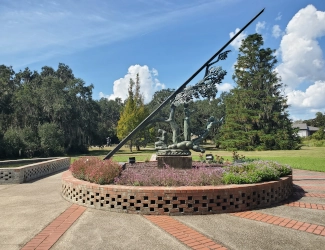
Image above: Sculpture depicting, the Visionaries, Anna Hyatt Hutchinson and her husband Archer, plus their dogs, 2025, America's Best History.
Spotlight on Lesser Known History
Brookgreen Gardens, South Carolina
America's Best History Spotlight
On this page we're going to Spotlight the lesser known historic sites and attractions that dot the history landscape across the USA and are worth a visit if you're in their area. And while they may be lesser known, some are very unique, and will be that rare find. You'll be, at times, on the ground floor, or maybe even know something others don't. It'll be fun. Visit them.

Brookgreen Gardens, South Carolina
While looking for some historic sites while in Myrtle Beach for a history friend to visit, I came across Brookgreen Gardens, a reknowned, but unknown to me, sculpture garden not far down the South Carolina coast. Now, I hate to admit this, but my history preferences run Civil War and the American West, and sculpture and art and flowers are lower on the totem pole. However, boy was I wrong. Brookgreen Gardens is an amazing collection of art and sculpture on nine thousand acres of land just off the beach in Murrells Inlet. It has over two thousand seven hundred works of art by four hundred and twenty-five artists, including the originators and owners of the property, famed and one of the female first sculptresses, Anna Hyatt Hutchinson, and her industrialist husband Archer Hutchinson. It is beautiful and historic, a myriad of pathways that lead you past metal, plaster, and bronze statues of a variety of sizes. There are sculpture galleries. Figures of Big Pigs and Bears. There is a zoo, cafes, gift shop, and a new Visitor Center that should be open sometime in 2026. So if you are in the Grand Strand area and want a different day than going to the beautiful beach and Atlantic Ocean, don't miss Brookgreen Gardens. How much is there to see? You get a seven day ticket so you can see it all.
Image above: Beautiful display of flowers and trees around a pond with central sculpture, 2025, America's Best History.
Sponsor this page. Your banner or text ad can fill the space above.
Click here to Sponsor the page and how to reserve your ad.
Info, What's There Now, History Nearby

Brookgreen Gardens, South Carolina
It was the vision of Anna Hyatt Hutchinson and augmented through her generosity to fund the property past her life that gives you this botanical treat. This is nine thousand acres of lowcountry land that won't see a bulldozer and ugly tract housing. This is nine thousand acres of whimsy that will delight the most jaded non art fan or child. Most of the exhibits are outdoors, although there are galleries and museums, too. The Rosan Galleries, Noble Gallery, Ron Daise Auditorium, Brown Sculpture Court, and the Lowcountry Gallery. A gardener's cottage greets you as you turn off the main road, taking you to the Admissions Plaza in an old cottage. We're not certain, but we think it is possible for you to enter in the Lowcountry area where there is also parking, but unsure if that is for everyone, or those who already have tickets. You can do a lot of walking or take a free shuttle around the property. When you get hungry, there are three restaurants; Austin's Harvest, The Old Kitchen, and the Courtyard Cafe.
Image above: Another sculpture, Pegusus, within Brookgreen Gardens, 2025. America's Best History. Below: Bronze sculpture, Dionysus, along trail, 2025, America's Best History.

Where Is It
Brookgreen Gardens is fifteen minutes south of Myrtle Beach in Murrells Inlet, South Carolina, just of Route 17, which parallels the ocean. It is located at 1931 Brookgreen Drive, Murrells Inlet, SC 29576.
Minute Walk in History
Brookgreen Gardens in Murrell's Inlet, South Carolina is a historic and beautiful oasis of nine thousand acres filled with sculpture, gardens, fountains, animals, and art. Its history stems from the fact that the gardens were built to showcase the sculpting of one of the first female sculptors, Anna Hyatt Huntington, plus others. It's a story of beauty, plus women's liberation into a field mostly dominant, at the time, by men. Walk the grounds with us. Only minutes from Myrtle Beach.
What is There Now
Brookgreen Gardens, South Carolina
Nine thousand acres of botanical gardens, trails, art galleries, and sculpture. Just some of the areas to visit include the Keepsakes Museum Shop, the Fountain of the Muses, Sampson and the Lion, Pegasus, Dionysus, Diana of the Chase, the Visionaries, Don Quixote, the Gazelle Fountain, boat rides, shuttle service, the Lowcountry Center, the Floyd Family Farm, the Campbell Nature Center, and the Lowcountry Zoo. It is open daily from 9:30 a.m. to 5:00 p.m. There are days when special events take place, such as the Night of a Thousand Candles, that there will or may be additional charges past those noted below. Dogs are not allowed. Bicycles are.
There are tours available daily, including the Laurel Hill and Springfield Excursion, the Creek Excursion, the Oaks Excursion, and the Brookgreen 101 Tour. All these have additional costs. Other programs such as the Mother Nature's Cafe tour, alligator feeding, and Meet the Animals are included with admission.
When Open and How Much
Fees are $23 for seniors, $25 for adults, $14 for 4-12, three and under free.
Fees and hours are subject to change.
Website
Brookgreen Gardens
History Nearby
Yes, there are the beaches of the Grand Strand stretching from Murrells Inlet and Pawley's Island on the southern end, through Myrtle Beach in the center, and Cherry Grove Beach to the north. Lots to do there from natural history with some American Revolution sites on the Liberty Trail and Civil War treasures sprinkled around the state.
Photos, History, and More Spotlights

Anna Hyatt Hutchinson
In 1930, after her diagnosis for tuberculosis, her industrialist husband Archer, one of the wealthiest men in the United States, and his famed sculptress wife Anna moved to South Carolina from the northeast to take advantage of the climate and hope that it would help her recovery. It did; she lived until ninety-seven years of age. Within eighteen months, the vision began to emerge as both decided to dedicate the property as a non-profit corporation to preserve Brookgreen Gardens for future generations. Anna had been a famed sculptor for many years, known for her use of metal as a medium, and at first the gardens were to contain her works. This has spread to over four hundred other artists today. There was a house in Brookgreen Gardens, no longer there, and a summer house built on the beach, called Atifaya Castle, a historic site in its own Moorish style right.
Born in 1876 in Cambridge, Massachusetts, her career took off in New York City. Her primary focus at the beginning of her career were sculptures of animals, which had been fostered by her zoology professsor father. By 1915, she was the first woman to have a public statue erected on Riverside Drive, Joan of Arc. Her marriage to Archer Huntington occurred in silence in 1923. He would buy her live tigers and other animals so she could use them as models. Her works of art are harbored in various museums and parks around the world.
Photo above: Painting of Anna Hyatt Hutchinson as she's working, 1915, Marion Boyd Allen. Courtesy Wikipedia Commons.
Buy Second Edition
America's Best History Timeline

Great book to keep middle school to college students up to date on their American history.

New Visitor Center Upcoming
Groundbreaking of the New Welcome Center and Conservatory Gardens was begun in Feburary 2024. It will be named the Purdy Center, and should be open sometime in 2026, although the Grand Opening date is not known and could be extended.
Image above: Sculpture inside one of the galleries with construction of new Visitor Center through the window in the background, 2025, America's Best History. Below: Map of Brookgreen Gardens outside the Rosen Gallery, 2025, America's Best History.


More Brookgreen Gardens
As we noted before, this is a botanical garden with classical style not far from works of whimsy. It seems to know that its clientele is not only sculptor patrons, but the regular patron, as well as children. Who wouldn't want their picture taken next to a Big Pig or Bear if you were younger than ... well any age. And that focus also allows youngsters to understand that art and sculpting is a bonafide, possible, yet difficult, field of study and work. And hopefully, broadens their minds to beauty and nature and the history of the lands that hold both man-made and God-made plants and wonders.
Photo above: In the Children's Garden, a sculpture of a big pig, 2025, America's Best History. Below: Sculpture, Time and the Fates of Man, as you approach the Lowcountry Exhibit and Zoo, 2025, America's Best History.

T-Shirts and Souvenirs

America's Best History T-Shirts, Sweatshirts, Backpacks, and other Souvenirs from the official gear of americasbesthistory.com.
About
America's Best History where we take a look at the timeline of American History and the historic sites and national parks that hold that history within their lands.
Photos courtesy of the Library of Congress, National Archives, National Park Service, americasbesthistory.com and its licensors.
- Contact Us
- About
- © 2025 Americasbesthistory.com.
Template by w3layouts.


